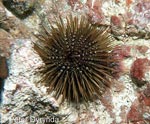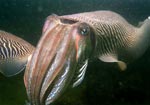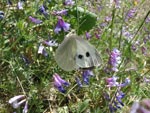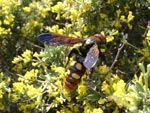|
|
|
|
 |
 |
| |
|
| |
| |
| Hobby [Falco subbuteo] |
| |
 |
 |
Adult birds seen from above are a fairly uniform blue-grey colour, while the underside is boldly streaked cream and grey, with a distinctive area of rust towards the tail. They share a curved cheek marking with the larger peregrine falcon, which they resemble. Although hobbies are among the smaller falcons, with the adults growing only to about 35cms in length, the |
| skill of these birds in the air is second to none. These hunters catch their prey on the wing. The young begin with slow-flying beetles and then graduate to the much faster dragonflies. Finally, as they grow, they learn to outfly and outmanoeuvre not only bats but also the members of the swallow family - one of the very few birds of prey that are able to do so. In consequence a good time to watch for them is at dusk when swallows are returning to their roosts, and bats are leaving theirs. As the swifts and swallows fly south to winter in Africa the hobbies follow, returning in the Spring. They construct twiggy nests in pine trees and rear their young which, until they are fledged, are covered in a mass of pale grey down that makes them look larger than their parents. Both adults take part in rearing the young, which they will continue to feed even after they have left the nest and until they are able to fend for themselves. |
| |
| back to the top |
 |
|
| |
| Sea urchin [Paracentrotus lividus] |
| |
 |
 |
Worldwide there are about 700 different species of sea urchins. They belong to the same family of animals as starfish - the echinoderms - and, like them, they have no central nervous system. The spines, each one of which is composed of many rods of calcium carbonate, can move from the base in all directions. They are a defence against predators and are also used to aid locomotion. Although we think of sea urchins as having a hard |
| outer shell or skeleton this is in fact covered by a layer of skin. Between the spines are lines of tentacles that help to keep the animal to feed and to remain anchored to the sea floor. Another type of tentacle is adapted for cleaning and feeding. The claw-like mouth with its five toothy plates (moved by 60 muscles) is on the animal's underside and is known as 'Aristotle's lantern' as the structure was described in ancient times by the philosopher. With this, the sea urchin scrapes algae from the rocks. The waste products of its digestion are ejected from the top side of the body, as are the eggs when they are released. Fertilisation takes place outside the female's body and a huge number of eggs - over a million - are released at a time. These float away and take months to develop into the form of the animal that we recognise. At an early stage the tiny larvae look like a half-opened umbrella - but without the fabric part. It takes between 2 and 5 years for sea urchins to reach maturity. Most never make it, falling prey before then to one of the many species that think of them, in spite of the spines, as a tasty snack. |
| |
| back to the top |
 |
|
| |
| Cuttlefish [Sepia officinalis] |
| |
 |
 |
Like the squid, nautilus and octopus to whose family - the cephalopods - the cuttlefish belongs, this curious animal has suckered tentacles and highly developed vision. Like the octopus it can change the colour of its skin, and is perhaps the animal that has refined this ability to the highest degree of all. Every square millimetre of its skin has up to 200 specialised pigment cells |
| within it. These, used in combination with a reflective layer of proteins that lie just beneath them, can produce a range of colours that spans almost the whole of the visible spectrum. Cuttlefish send complex visual signals to one another to attract a mate or repel a rival, and can also camouflage themselves to help with hunting and avoiding predators. Like an octopus a cuttlefish can send out a cloud of black ink if it feels threatened and has a similarly powerful beak that can even bite through the hard shell of a crab - one of its favourite foods. In common with centipedes, spiders, scorpions and crabs, the blood of cuttlefish is not red but greeny-blue. This is because none of these animals use an iron-based protein to carry oxygen round their bodies. In place of haemoglobin they use haemocyanin, which is based on copper. Unfortunately it is less efficient at binding with oxygen than haemoglobin, so the cuttlefish needs a very active circulation - it has evolved three separate hearts to do the job. Mating cuttlefish look as though they are wrestling with each other as they lock tentacles, face to face. Once the eggs have been safely deposited, the parents die, and we may find their remains washed up on the beach in the form of a white, torpedo-shaped bone with a porous structure that once provided its owner with both rigidity and buoyancy. |
| |
| back to the top |
 |
|
| |
| Tortoise [Testudo graeca] |
| |
 |
 |
Experts are still arguing about the precise definitions and divisions of the various subspecies within this adaptable group of reptiles. The Balkans, the Middle East and North Africa support closely interrelated species of tortoises. In Chios Testudo graeca is certainly present, hatching (from white, spherical eggs that have been hidden underground) as the first rains of Autumn begin |
| and the vegetation, on which tortoises depend for their food, is renewed. Mating is a noisy affair with the smaller male not only knocking his shell repeatedly against the female's but also making a series of loud squeaks. The fertilised females excavate a nest using their hind legs and can lay several times after just one successful mating. The eggs (there may be about 15) are then buried and the earth is stamped back down. Once laid, tortoise eggs cannot be turned without damage to the developing embryo. This is because the yolk and albumen are not, as in birds, separated by a membrane. The heavier yolk parts simply sink and collect at the bottom of the egg. Incubation in the Mediterranean region is shorter than in the tropics and varies (depending on the temperature) between 60 and 100 days. Hatchlings use a special egg-tooth to break the shell, but normally remain safely underground for the first two weeks, living on the remains of the yolk. Once in the open they must, for the rest of their lives, take care to control their body temperature by coming out to bask in the sun in the morning and sheltering from the midday heat in Summer by returning to the nearest available "scrape". This might be at the roots of a shady kermes oak or under a rock. Scrapes do not seem to be 'owned' by any one individual. Different animals use them according to how close they are to where they have been grazing. When there is none available nearby and night is falling, a new one will be made. If temperatures become too extreme tortoises can both hibernate and aestivate, re-emerging once conditions have become more to their liking. |
| |
| back to the top |
 |
|
| |
| Large white butterfly [Pieris brassicae] |
|
| |
 |
 |
This attractive white butterfly is quite a common sight across many parts of Europe. The adult, with its broadly black-tipped forewings, may be seen gathering nectar from flowers throughout the warmer months of the year. But while many welcome its first appearance as a sign of lengthening days and improving weather, gardeners regard it as a serious pest. This is because its |
| caterpillars feed on the leaves of plants in the brassica family - cauliflowers, cabbages, broccoli and more besides. When the caterpillar first hatches from one of the 20-50 eggs that have been deposited clustered together on the underside of a leaf, it feeds on the surface only, causing relatively little damage. But once it has grown and shed its skin for the second time, its appetite increases and the more powerful jaws can cut right through a leaf, leaving large holes. The bristly caterpillar, which is mottled grey-green with black spots and yellow stripes, uses chemicals absorbed from its food to produce mustard-oil in its body. This makes it unpleasant-tasting to many of the animals that would otherwise eat it. When it turns into a pupa for the final stage of its development, it does not spin a silk cocoon like many other species, but simply binds itself to a twig, wall or fence post with a fine girdle of silk. There are usually two generations bred each year - sometimes more - but it is in the pupal stage that the insects overwinter, to emerge as adults the following Spring. |
| |
| back to the top |
 |
|
| |
| Mammoth wasp [Scolia flavifrons] |
| |
 |
 |
This widespread wasp that is found throughout the Balkan region is the largest in Chios. Its wingspan can be up to 6cms across, but although it certainly has a sting it rarely poses any threat to humans as it feeds on nectar when in its adult form. Males look similar to the larger females but even when a size comparison is not possible females can be identified by the yellow |
| colouring of their heads, and their large mandibles. In the Spring dark-headed males emerge first from the underground cocoon that has been their shelter over the winter. They immediately start searching for the emerging females with which they will mate in a brief moment of intimacy that lasts only between one and four seconds. The fertilised females must find nectar-bearing flowers to feed on before their eggs can mature enough to be laid. With this task complete they start flying low over the ground looking for the scent of a beetle grub. When they think they have discovered one they will dig for it and, having found it, sting it into a state of paralysis. Then they will lay a single egg beside it and leave the two together in the grub's underground burrow. In two or three days the wasp egg will hatch and the wasp larva will feed on the paralysed beetle grub, eating it alive. It is likely that any of the many beetles that make up the scarab family would be considered suitable by the mammoth wasp, but it is certain that the wasps will target the rhinoceros beetle, when they can find it. In a curious way beetles in general take advantage of the wasp also - but somewhat indirectly. Since it is a stinging insect that announces the fact clearly through its appearance, predators have learned to avoid it. Many species of beetle (though not the unfortunate rhinoceros) have evolved patterns of colour that mimic the wasp, sending a deceptive message to animals that might otherwise feed on them - Watch out, I sting. look for your meal somewhere else! |
| |
| back to the top |
 |
|
| |
| Rhinoceros beetle [Oryctes nasicornis] |
| |
|
 |
The Hercules of the beetle world, and actually the strongest creature on earth, a rhinoceros beetle can lift up to 850 times his own weight, whereas a fully grown elephant can only manage 25% of his. There are many different species of them, some of which grow truly enormous and are even kept as pets, but the |
| European version is not among these monsters since it only grows to a maximum of 4cms long. In spite of their rather ferocious appearance these are gentle giants that neither bite nor sting. Both males and females can open their hard, glossy wing cases and fly, which they do after dusk, but only the male has a horn. He uses it to fight off other males when the time comes to find a mate. Unfortunately the horn is no use at all when it comes to fending off a hungry owl! Most of the insect's life is spent in the larval stage, feeding on rotting wood. The grub is white with a rusty-coloured head and large mandibles. If it is lucky and avoids being spotted by a female wasp (see note on Scolia flavifrons above) it will go through three stages of moulting and growth before it reaches its full length of up to 12cms. Then it will pupate, ceasing to feed and turning an amber colour. At this stage the outline of the male's horn begins to be clearly visible. Development can take between one and five years, depending on conditions and the availability of suitable food. In Chios the beetles appear to be more plentiful every four years, suggesting that there is a natural four-year cycle in operation. Once the adults emerge they don't devote much time to feeding, their main aim being to find a mate and produce the next generation, nevertheless they have been observed feeding on sap, nectar and rotting fruit. |
| |
| back to the top |
 |
|
| |
| Caterpillar of spurge hawk moth [Hyles euphorbiae] |
| |
|
 |
As spurge hawk moths can reproduce twice a year these caterpillars may be seen in both Spring and Summer. They will have hatched from very small eggs that are only about 1mm across, glossy green-blue in colour and almost spherical in shape. Remarkably these tiny eggs have such a hard outer casing that if they are dropped onto a hard surface they bounce! The caterpillars, like the adults they will become, vary greatly in appearance from region to region of the large range of this species, and can be hard to identify with certainty for this reason. A line of bright "eye" spots along the length of the body is usual, and all exhibit a 'horn' at the rear end of the body. While they are small they remain low on their food plant, the euphorbia, venturing higher at night. As they grow they become bolder, enjoying the protection of their increasingly bright warning markings. These are a clear warning to any predator that the caterpillars are becoming as poisonous as the plant they feed on. If disturbed they can shoot a distasteful liquid from the mouth at any attacker. They are most active just before pupation at which time they will travel substantial distances from their host plants. By then they will have reached a length of 70-80mm - the same length as the span of the adult insect's wings. The amber-coloured pupa is not as long, and can be found on the ground, inside a net-like cocoon that is loosely spun and includes soil and leaf debris. In this state the animals overwinter, and may spend anything from two weeks to two years, depending on conditions. The adult moth is a relatively large creature of striking appearance that has predominantly cream and brown/green, dagger-shaped |
| markings on its wings. During daylight hours it rests on stones, low walls or even on the ground, becoming active between dusk and midnight, when it will take to the wing to seek out either nectar-bearing flowers, such as nicotiana, to feed on, or a mate. In marked contrast to the swift pairings of the mammoth wasp , mating spurge hawk moths remain conjoined for up to three hours. The female will begin to lay her eggs immediately after separation, gradually increasing the size of the cluster she deposits over a few nights until about ten are placed together, always on a suitable food plant, discreetly on the underside of a leaf. |
| |
| back to the top |
 |
|
| |
| Sea star [Echinaster sepositus] |
| |
 |
 |
Like the sea urchin echinaster sepositus is a member of the echinoderm family. It lives in relatively shallow water and is not found below 200m. In common with its spiny cousin the mouth parts are on the underside of the body and it reproduces by releasing huge numbers of unfertilised eggs into the water. |
| No mating takes place. The bright orange surface of its body is covered with a soapy-textured skin, and it can extend small tentacles that grip the rocks and help it to move. At the tip of each of its five arms there is a simple eye structure that can only detect changes in light levels. Remarkably, sea stars can recover from serious injuries provided a section of their central disc has remained intact, even managing to grow whole new arms. They have a unique system of movement that, like their bloodless circulation, is based on hydraulics, sending water through a network of vessels. There is no hard, shell-like skeletal structure. What rigidity they have is provided by many small, bony plates. This is why, unlike a sea urchin, sea stars that die naturally in the wild leave very little that can easily be found after their death and the decay of their soft tissues. The hydraulic movement system works only slowly but it is very strong. This is why sea stars are able to open the shells of molluscs by force. Once they have done that, they can extend one of their two stomachs outside their bodies and into the partly opened shell of their prey. Once inside, enzymes that dissolve the flesh of the victim are released, making a nutrient-rich soup that the sea star can suck up and digest. These feeding methods result in the pairs of clean, empty shells that can often be found washed up along the beach. |
| |
| back to the top |
 |
|
| |
| Bee fly [Anastoechus nitidulus] at cistus blossom |
| |
 |
 |
This is one of nature's impostors. In reality a fly that neither bites nor stings, the many species of bee fly that can be found (about 4,500 in all, and on every continent except Antarctica) are dressed up to look like a stinging insect for their own protection. Under the furry disguise the outline of this agile flyer's body is much more like that of a fly than a bee. Like all true flies it has only |
| a single pair of wings that are swept back when the insect is at rest, like those of a jet fighter! The long proboscis through which it feeds can clearly be seen in this photograph, taken by naturalist Mike Taylor on Chios where ninety five separate species of the insect have been recorded. Many of these prefer to suck up nectar while hovering, rather than landing on the flower. This is almost certainly another protection behaviour that helps the feeding insect to avoid being caught by one of the predators that hang around flowers waiting for a meal - a crab spider, for example. Between feeds it will alight in a more discreet and protected place to rest before setting off again. Further protection comes from more mimicry - the bee fly makes a loud buzzing noise in flight. This is the adult form of the insect; its larvae, like those of the mammoth wasp, are parasitic, and having emerged from eggs that have been laid on the ground, will feed on a beetle grub. Bee flies have also been observed using their hovering abilities to parasitise other species, such as the mason bee. Having located a nest tunnel, in a clay bank or man-made mortar, the female bee fly will turn in the air to face away from the entrance and eject her egg backwards into the tunnel. Being the stronger of the two, the emerging bee fly larva will use up the food supply left by the mason bee for its own young. |
|
| |
|
|




